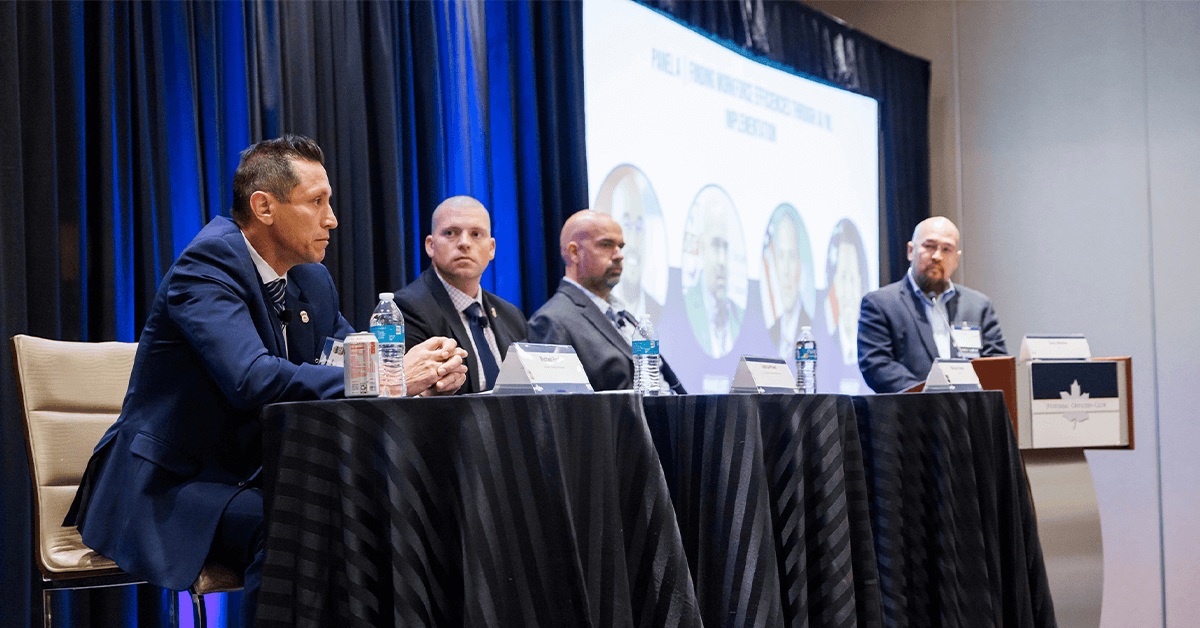As artificial intelligence gains more traction across the federal landscape, government officials are finding that AI technologies have the power to dramatically transform and augment the workforce. However, federal leaders warn that we must be equally focused on the benefits and threats unlocked by AI.
Will AI Replace Humans?
Across the board, government decision makers firmly believe that AI will never replace humans. Instead, they see AI as a tool that will become essential in supporting human operators and allowing them to focus on higher cognitive work.
“Some of these technologies, while they never will replace a human, they have the ability to make even beginner users super users at the onset,” said Joshua Powell, deputy chief AI officer at the U.S. Customs and Border Protection, during a panel discussion led by LMI’s Gary Barber at the Potomac Officers Club’s 2024 Homeland Security Summit last week.
“That’s really fundamentally what we’re trying to get these things to. Can we make every user as good as our best user and start to derive better outcomes?” Powell said.
Mike Prado, deputy assistant director for the Homeland Security Investigations’ Cyber Crimes Center, agreed, noting that while AI can positively impact homeland security investigations, its real potential lies in empowering users.
“AI can only get us so far, and get us an investigative lead and point us in the right direction. But it’s the workforce — it’s investing in our workforce, keeping them trained up on how to use this tool, to not solely rely on it, and then get to the day-to-day business of conducting an investigation, attributing the attack and trying to bring those individuals to full identification,” Prado explained.

Uncovering AI Risks
Powell urged that government and industry leaders can’t limit their view of AI to just its potential — they must also seriously consider how to protect their organizations from the risks posed by the technology, especially when it comes to cybersecurity.
“We have AI we need to bring in to help impact our cybersecurity concerns, but we also have to be aware that on the outside, they’re using AI to produce security concerns. So how do we kind of thread that needle and monitor both sides?” Powell asked.
“You have to worry about the promise and the peril,” he added.
Powell noted that CBP is exploring post-quantum cryptography in anticipation of potential future cyber threats fueled by AI and quantum technologies.
Deploying AI/ML in Homeland Missions
AI and machine learning technologies are not new for most federal agencies. But with the acceleration in AI development, agencies are having to move faster than ever to keep up with the advancements and the threats.
HSI, for example, is making significant investments in machine learning tools that can help “connect the dots” and inject the investigations process with more speed and efficiency, according to Prado.
“The biggest thing for us in an investigative standpoint is using machine learning and AI tools to take all of our reports of investigation — spread amongst our 235 domestic field offices, our 90 plus foreign offices — and be able to make those links when we’re investigating,” Prado shared.
Prado also noted that HSI has deployed ML to identify anomalies in internet traffic that can allow the agency to preemptively detect network intrusion events before they happen. He highlighted that HSI has been “tremendously successful” in preventing cyber attacks, but the agency’s success in this area would not have been possible at that scale without the ML tools they use.
Industry’s AI Innovations
The private sector is also working hard to deliver innovative AI tools and technologies that can help federal agencies better execute their missions. Mike Hardee, chief architect for law enforcement and justice at Red Hat, said his company has been developing a platform called Podman AI Lab that can help agencies experiment with AI in a secure setting.
“We’ve introduced Podman AI Lab, where essentially now you’re able to adopt AI in a container context and begin working and getting familiar and building that training muscle in a community context, in a safe place,” said Hardee.
Hardee said Podman AI Lab allows users to download large language models and work through use cases without impacting missions.

Curious about the future of AI in the public sector? Don’t miss the Potomac Officers Club’s 2025 Defense R&D Summit on Jan. 23, where government and industry experts will gather to discuss the tech innovations powering the defense landscape. Save your seat today for the 2025 Defense R&D Summit!



